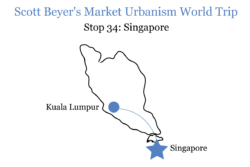The Anatomy of a Chinese Ghost City
The Chinese build cities that fall way under population projections. Who keeps funding this and why does it happen?
Rapid urbanization, from farms into cities, has been the theme of Third World development for decades. But in China it’s on a whole other level. Home to a quarter of the world’s 100 largest cities, China’s urban population grew from just 13% in 1950 to 45% in 2010, with projections continuing upward. But the country and its desired international sphere of influence are also home to the curious phenomenon of “ghost cities”—large clusters of towers and infrastructure with few residents. These result from governance problems that inflict China and other countries worldwide, as I got to see firsthand while visiting a Chinese-funded project in Malaysia.
I’m profiling a Malaysian one because I won’t visit China during my 1.5-year Global South tour, due to security risks. But the project’s being built by a Chinese developer, backed by Chinese investors, and now contains only about 1% of its projected population, so I got the idea behind this ghost city phenomenon.
Forest City is the high-profile megaproject near the Malaysia-Singapore border. Spanning over 187,000,000 square feet on four man-made islands, the project was built by Country Garden and the Malaysian government. Country Garden is not a state-owned enterprise, but Forest City was part of the initial round of China’s Belt and Road Initiative. Chinese investors view it as a way to access the growing Singapore and Malaysian markets. Its claim to fame is that much of the traffic infrastructure has been built underground, making it a mostly pedestrian city. I went on a rainy Sunday expecting to be blown away. But the story was mixed.
On one hand, Forest City is extremely well-built. The sales center is big and spacious and shows a beautiful rendering. The streets are immaculate and safe, and true to its name, there are many parks and tree-lined boulevards.
The problem is few live there.
While projected to house 700,000 people by 2035, it now only has 9,000 residents. It seems like even less than that when walking around; security guards and other staffers are the main street presence. Business Insider correspondent Marielle Descalsota, visiting in 2022, had a similar experience.
“Every shop I saw in the complex appeared to be closed, empty, or abandoned,” Descalsota wrote, noting that on the ground sources said that as few as 20 people lived in one large apartment building.

Part of the problem is protectionism. In 2018, the Malaysian prime minister, who was opposed to the project before holding office, announced that foreigners would be forbidden from any longer buying property in Forest City. The developers dispute this, but the uncertainty has nonetheless slowed sales. On China’s end, capital control rules limit how much Chinese residents could pay for overseas investments like Forest City.
Bad timing plays a role too: the project opened not long before the COVID crisis, during which Malaysia closed its borders. Additionally, Country Garden is facing a dire financial outlook, and has not been able to allocate its full projected investment into Forest City.
But I saw more specific issues. For one, the project is poorly located, distant from both Singapore and the nearby Malaysian border city Johor Bahru. For another, it is surveilled to a degree that far exceeds the area’s actual crime risk.
Getting in is difficult: instead of streamlining the checkpoint process, as towns along the US-Mexico border do, the Singapore-Malaysia border is securitized to the hilt. Instead of just taking a 30-minute cab from downtown Singapore to Forest City, one must go through a processing center on each side of the border, with a shuttle bus connecting the two. Getting there and back took 4 hours total.
I could never imagine living in such an Orwellian atmosphere, and most Asians can’t either: at this point, Forest City is mostly just a Chinese overseas investment vehicle full of empty units.
This is reflected in the ghost cities in China itself: the World Economic Forum reports that there are at least 24 in the country and another 65 million vacant housing units. There are a few reasons for this over-speculation.
For one, China’s urbanization, rapid though it is, led to overconfident predictions about demand for new cities.
“Too often in China, local officials have sought to give the appearance of development, sometimes without that much concern for achieving the real thing,” WEF writes.
For example, China takes on lots of debt to build major public infrastructure projects, and thinks building new cities around them will justify the investment. This top-down planning approach leads to ghost cities.
It’s not a uniform story of failure. Zhengzhou’s New District grew 27.5% from 2019 to 2020 alone, Bloomberg reports, attributable to a nearby factory which assembles a large percentage of the world’s iPhones. While in Indonesia, I visited PIK 2, a land reclamation project that has also drawn Chinese investment. It’s proving far more successful because it is just north of the Jakarta border and has no barriers to entry, save a small bridge toll.
Forest City may eventually come along: the Malaysian government just announced plans to make it a special economic zone. But by and large, its story is that of other ghost cities, and at least some of the other private “startup cities” I’m profiling on my tour: mislocated, high-expense, and above all, subject to the grip of outside governments. No matter how well-run or innovative Forest City may be, it will always be held down by Malaysia-Singapore border controls, along with other regulatory friction. It’s another reminder that laudable attempts at local governance and autonomy are ultimately at the mercy of the central planners surrounding it.
Graphic Credit: The Market Urbanist.
Catalyst articles by Scott Beyer | Full Biography and Publications
